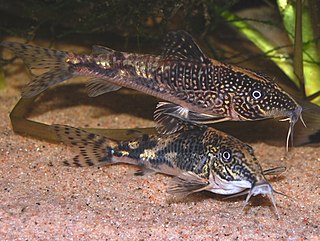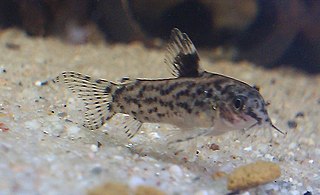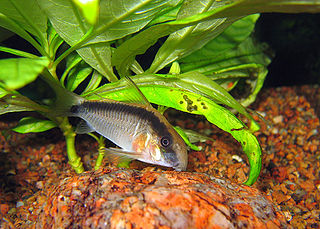- Corydoras acrensis Nijssen, 1972 (Acre corydoras)
- Corydoras acutus Cope, 1872 (Black-top corydoras)
- Corydoras adolfoi W. E. Burgess, 1982 (Adolfo's catfish)
- Corydoras aeneus (T. N. Gill, 1858) (Bronze corydoras)
- Corydoras agassizii Steindachner, 1876 (Agassiz's corydoras)
- Corydoras albolineatus Knaack, 2004 (White stripe cory)
- Corydoras amandajanea Sands, 1995 (Amanda Jane's cory)
- Corydoras amapaensis Nijssen, 1972 (Amapa corydoras)
- Corydoras ambiacus Cope, 1872 (Spotted corydoras)
- Corydoras amphibelus Cope, 1872 (Mystery cory)
- Corydoras apiaka Espíndola, M. R. S. Soares, L. R. Rosa & M. R. Britto, 2014 [22] (Arinos cory)
- Corydoras approuaguensis Nijssen & Isbrücker, 1983 (Zebratail cory)
- Corydoras araguaiaensis Sands, 1990 [23] (Araguaia cory)
- Corydoras arcuatus Elwin, 1938 (Skunk corydoras)
- Corydoras areio Knaack, 2000 (Hump cory)
- Corydoras armatus (Günther, 1868) (Sail cory)
- Corydoras atropersonatus S. H. Weitzman & Nijssen, 1970 (Fairy catfish)
- Corydoras aurofrenatus C. H. Eigenmann & C. H. Kennedy, 1903 (Goldhead cory)
- Corydoras axelrodi Rössel, 1962 (Pink corydoras)
- Corydoras baderi Geisler, 1969 (Road cory)
- Corydoras benatti Espíndola, Tencatt, Pupo, Villa-Verde & Britto, 2018 (Speckled xingu cory)
- Corydoras bicolor Nijssen & Isbrücker, 1967 (Two-tone cory)
- Corydoras bifasciatus Nijssen, 1972 (Two-stripe corydoras)
- Corydoras bilineatus Knaack, 2002 (White-striped corydoras)
- Corydoras blochi Nijssen, 1971 (Spotback corydoras)
- Corydoras boehlkei Nijssen & Isbrücker, 1982 (Caura cory)
- Corydoras boesemani Nijssen & Isbrücker, 1967 (Boeseman's catfish)
- Corydoras bondi Gosline, 1940 (Black-stripe corydoras)
- Corydoras breei Isbrücker & Nijssen, 1992 (Avanavero cory)
- Corydoras brevirostris Fraser-Brunner, 1947 (Spotted collar cory)
- Corydoras britskii (Nijssen & Isbrücker, 1983) (Britski's catfish)
- Corydoras brittoi Tencatt & Ohara, 2016 [24]
- Corydoras burgessi H. R. Axelrod, 1987 (Burgess's catfish)
- Corydoras carlae Nijssen & Isbrücker, 1983 (Carla's cory)
- Corydoras caudimaculatus Rössel, 1961 (Tailspot corydoras)
- Corydoras cervinus Rössel, 1962 (Deer-faced cory)
- Corydoras cochui G. S. Myers & S. H. Weitzman, 1954 (Barredtail corydoras)
- Corydoras colossus Tencatt, S. Grant, Bentley, 2023 [25] (Colossus cory)
- Corydoras concolor S. H. Weitzman, 1961 (Slate cory)
- Corydoras condiscipulus Nijssen & Isbrücker, 1980 (Schoolmate cory)
- Corydoras copei Nijssen & Isbrücker, 1986 (Lake cory)
- Corydoras coppenamensis Nijssen, 1970 (Chopstick cory)
- Corydoras coriatae W. E. Burgess, 1997 (Hermit cory)
- Corydoras cortesi D. M. Castro, 1987 [26]
- Corydoras costai Ottoni, Barbosa & Katz, 2016 [27]
- Corydoras crimmeni S. Grant, 1997 (Blackwater cory)
- Corydoras cruziensis Knaack, 2002 (Santa Cruz cory)
- Corydoras crypticus Sands, 1995 (Yellow head cory)
- Corydoras davidsandsi B. K. Black, 1987 (Sands's corydoras)
- Corydoras delphax Nijssen & Isbrücker, 1983 (False blochi catfish)
- Corydoras difluviatilis M. R. Britto & R. M. C. Castro, 2002 (Sparano cory)
- Corydoras diphyes Axenrot & S. O. Kullander, 2003 (Variable cory)
- Corydoras duplicareus Sands, 1995 (Duplicate corydoras, broadstripe cory)
- Corydoras ehrhardti Steindachner, 1910 (Olive cory)
- Corydoras elegans Steindachner, 1876 (Elegant corydoras)
- Corydoras ellisae Gosline, 1940 (Two point cory)
- Corydoras ephippifer Nijssen, 1972 (Saddle corydoras)
- Corydoras eques Steindachner, 1876 (Horseman's corydoras)
- Corydoras esperanzae D. M. Castro, 1987 (Orocue cory)
- Corydoras evelynae Rössel, 1963 (Evelyn's cory)
- Corydoras eversi Tencatt & M. R. Britto, 2016 [23] (Guarana cory)
- Corydoras filamentosus Nijssen & Isbrücker, 1983 (Filament cory)
- Corydoras flaveolus R. Ihering (pt), 1911 (Yellow cory)
- Corydoras fowleri J. E. Böhlke, 1950 (Fowler's cory)
- Corydoras froehlichi Tencatt, M. R. Britto & Pavanelli, 2016 [28]
- Corydoras fulleri Tencatt, Evers, H-G & Britto 2021. [29] (Fuller's cory)
- Corydoras garbei R. Ihering, 1911 (Bahia cory)
- Corydoras geoffroy Lacépède, 1803 (Wolf cory)
- Corydoras geryi Nijssen & Isbrücker, 1983 (Bolivian cory)
- Corydoras gladysae Calviño & F. Alonso, 2010 (Gladys's cory)
- Corydoras gomezi D. M. Castro, 1986 (Leticia cory)
- Corydoras gossei Nijssen, 1972 (Pale-spotted corydoras)
- Corydoras gracilis Nijssen & Isbrücker, 1976 (Shy cory)
- Corydoras griseus Holly, 1940 (Grey corydoras)
- Corydoras gryphus Tencatt, M. R. Britto & Pavanelli, 2014 [30] (Dragon-fin cory)
- Corydoras guapore Knaack, 1961 [31] (Guapore corydoras)
- Corydoras guianensis Nijssen, 1970 (Light cory)
- Corydoras habrosus S. H. Weitzman, 1960 (Salt and pepper catfish)
- Corydoras haraldschultzi Knaack, 1962 (Mosaic corydoras)
- Corydoras hastatus C. H. Eigenmann & R. S. Eigenmann, 1888 (Dwarf corydoras)
- Corydoras hephaestus Ohara, Tencatt & M. R. Britto, 2016 [32] (Fireball cory)
- Corydoras heteromorphus Nijssen, 1970 (White cory)
- Corydoras imitator Nijssen & Isbrücker, 1983 (Imitator cory)
- Corydoras incolicana W. E. Burgess, 1993 (Icana cory)
- Corydoras isbrueckeri Knaack, 2004 (Brazil longnose cory)
- Corydoras julii Steindachner, 1906 (Julii corydoras)
- Corydoras kanei S. Grant, 1998 (Kane's cory)
- Corydoras knaacki Tencatt & Evers, 2016 [33] (Knaacks cory)
| - Corydoras lacerdai Hieronimus, 1995 (Lacerda's cory)
- Corydoras lacrimostigmata Tencatt, M. R. Britto & Pavanelli, 2014 [34] (Tearful cory)
- Corydoras lamberti Nijssen & Isbrücker, 1986 (Lambert's cory)
- Corydoras latus N. E. Pearson, 1924 (Wide cory)
- Corydoras leopardus G. S. Myers, 1933 (Leopard corydoras)
- Corydoras leucomelas C. H. Eigenmann & W. R. Allen, 1942 (False spotted catfish)
- Corydoras longipinnis Knaack, 2007 (Long-finned cory)
- Corydoras loretoensis Nijssen & Isbrücker, 1986 (Loreto cory)
- Corydoras loxozonus Nijssen & Isbrücker, 1983 (Dirty bandit cory)
- Corydoras lymnades Tencatt, Vera-Alcaraz, M. R. Britto & Pavanelli, 2013 [35] (Nose stribed cory)
- Corydoras maculifer Nijssen & Isbrücker, 1971 (Dotted corydoras)
- Corydoras mamore Knaack, 2002 (Marmore cory)
- Corydoras melanistius Regan, 1912 (Blue-spotted corydoras)
- Corydoras melanotaenia Regan, 1912 (Green-gold catfish)
- Corydoras melini Lönnberg & Rendahl (de), 1930 (Bandit corydoras)
- Corydoras metae C. H. Eigenmann, 1914 (Masked corydoras)
- Corydoras micracanthus Regan, 1912 (Andes cory)
- Corydoras microcephalus Regan, 1912 (Peppered Argentina cory)
- Corydoras multimaculatus Steindachner, 1907 (Many-spotted cory)
- Corydoras multiradiatus (Orcés-V. (es), 1960) [23] (Hognosed brochis)
- Corydoras nanus Nijssen & Isbrücker, 1967 (Little corydoras)
- Corydoras napoensis Nijssen & Isbrücker, 1986 (Rio Napo cory)
- Corydoras narcissus Nijssen & Isbrücker, 1980 (Narcissus corydoras)
- Corydoras nattereri Steindachner, 1876 (Blue corydoras)
- Corydoras negro Knaack, 2004 (Rio Negro cory)
- Corydoras nijsseni Sands, 1989 (Nijssen's corydoras)
- Corydoras noelkempffi Knaack, 2004 (Meander cory)
- Corydoras oiapoquensis Nijssen, 1972 (Flag-tailed panda cory)
- Corydoras ornatus Nijssen & Isbrücker, 1976 (Ornate cory)
- Corydoras orphnopterus S. H. Weitzman & Nijssen, 1970 (Rabbit cory)
- Corydoras ortegai M. R. Britto, F. C. T. Lima & M. H. Hidalgo, 2007 (Loreto panda cory)
- Corydoras osteocarus J. E. Böhlke, 1951 (Bonehead cory)
- Corydoras ourastigma Nijssen, 1972 (Long-nosed smudgespot cory)
- Corydoras oxyrhynchus Nijssen & Isbrücker, 1967 (Sharp-nosed cory)
- Corydoras paleatus (L. Jenyns, 1842) (Peppered corydoras) [28]
- Corydoras panda Nijssen & Isbrücker, 1971 (Panda corydoras)
- Corydoras pantanalensis Knaack, 2001 (Pantanal cory)
- Corydoras paragua Knaack, 2004 (Paragua cory)
- Corydoras parallelus W. E. Burgess, 1993 (Two-line cory)
- Corydoras pastazensis S. H. Weitzman, 1963 (Pastaza corydoras)
- Corydoras paucerna Knaack, 2004 (Cuddly cory)
- Corydoras pavanelliae Tencatt & Ohara, 2016 [24]
- Corydoras petracinii Calviño & F. Alonso, 2010 (Petracini's cory)
- Corydoras pinheiroi Dinkelmeyer, 1995 (Mario's cory)
- Corydoras polystictus Regan, 1912 (Fine-spotted cory)
- Corydoras potaroensis G. S. Myers, 1927 (Potaro cory)
- Corydoras pulcher Isbrücker & Nijssen, 1973 (Pretty corydoras)
- Corydoras punctatus (Bloch, 1794) (Spot-fin corydoras)
- Corydoras pygmaeus Knaack, 1966 (Pygmy corydoras)
- Corydoras rabauti La Monte, 1941 (Rusty corydoras)
- Corydoras reticulatus Fraser-Brunner, 1938 (Reticulated corydoras)
- Corydoras reynoldsi G. S. Myers & S. H. Weitzman, 1960 (Bumblebee cory)
- Corydoras robineae W. E. Burgess, 1983 (Banner-tail corydoras)
- Corydoras robustus Nijssen & Isbrücker, 1980 (Robust cory)
- Corydoras sanchesi Nijssen & Isbrücker, 1967 (Gojo cory)
- Corydoras saramaccensis Nijssen, 1970 (Saramaccensis cory)
- Corydoras sarareensis Dinkelmeyer, 1995 (Sarare cory)
- Corydoras schwartzi Rössel, 1963 (Schwartz's catfish)
- Corydoras semiaquilus S. H. Weitzman, 1964 (Peru black cory)
- Corydoras septentrionalis Gosline, 1940 (Northern kongnose cory)
- Corydoras serratus Sands, 1995 (Sawtooth cory)
- Corydoras seussi Dinkelmeyer, 1996 (Seuss's cory)
- Corydoras similis Hieronimus, 1991 (Smudgespot cory)
- Corydoras simulatus S. H. Weitzman & Nijssen, 1970 (Olga cory)
- Corydoras sipaliwini Hoedeman, 1965 (Nail cory)
- Corydoras sodalis Nijssen & Isbrücker, 1986 (False network catfish)
- Corydoras solox Nijssen & Isbrücker, 1983 (Club cory)
- Corydoras spectabilis Knaack, 1999 (Millennium cory)
- Corydoras spilurus Norman, 1926 (Pink-throat corydoras)
- Corydoras splendens (Castelnau, 1855) (Emerald corydoras)
- Corydoras steindachneri Isbrücker & Nijssen, 1973 (Paraná corydoras)
- Corydoras stenocephalus C. H. Eigenmann & W. R. Allen, 1942 (Huangana cory)
- Corydoras sterbai Knaack, 1962 (Sterba's corydoras)
- Corydoras surinamensis Nijssen, 1970 (Suriname cory)
- Corydoras sychri S. H. Weitzman, 1960 (Sychr's catfish)
- Corydoras treitlii Steindachner, 1906 (Long-snout corydoras)
- Corydoras trilineatus Cope, 1872 (Three-stripe corydoras)
- Corydoras tukano M. R. Britto & F. C. T. Lima, 2003 (Tukano cory)
- Corydoras undulatus Regan, 1912 (Wavy catfish)
- Corydoras urucu M. R. Britto, Wosiacki & Montag, 2009 (Urucu cory)
- Corydoras virginiae W. E. Burgess, 1993 (Miguelito corydoras)
- Corydoras vittatus Nijssen, 1971 (Stripy cory)
- Corydoras weitzmani Nijssen, 1971 (Two-saddle corydoras)
- Corydoras xinguensis Nijssen, 1972 (Xingu corydoras)
- Corydoras zawadzkii Tencatt & Ohara, 2016 [26]
- Corydoras zygatus C. H. Eigenmann & W. R. Allen, 1942 (Black-band catfish)
- † Corydoras revelatus Cockerell, 1936 Fossil species from the Late Paleocene
|














